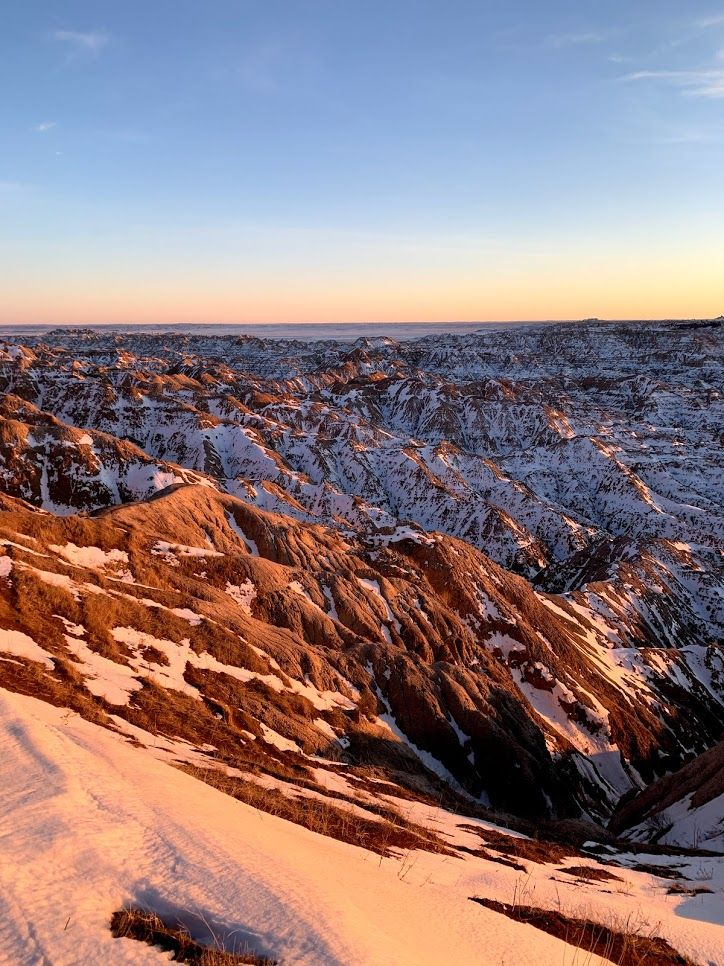Badlands National Park March 2021 Trip Report

March 1, 2021
On Day 3 of our move from New York to Seattle, Washington, we took a day off from driving to hike Badlands National Park! It was my favorite day of our cross country road trip.

We stopped at an overlook soon after entering the park. The Badlands were unlike anything I had ever seen before. They reminded me most of home, the erosion similar to the cliff bluffs of Montauk or even the carved walls of the Grand Canyon. The way the Badlands formations suddenly rose out of nothing from the grasses of the prairie was like approaching the rocks of Pinnacles National Park. Staring into ravines unlocked an instinctual fear to keep away from the edge.

The weather was perfect– blue, sunny skies and a comfortable temperature. Despite the beautiful weather, it was a weekday in the off-season so the park was empty! We barely saw anyone else at all, and didn't run into anyone else on trail. Badlands National Park also only receives about a million visitors a year, compared to busier parks like Great Smoky Mountains that receive 12.5 million visitors.

We hiked the Door Trail, Window Trail, Notch Trail, Fossil Exhibit Trail, and parts of the Castle and Saddle Pass Trails.
Badlands National Park also has an "Open Hike Policy" which means you are allowed to hike off-trail as well. However, caution is warranted since the Badlands formations can be difficult to down-climb and the South Unit of the park was a former bombing range.

The Notch Trail was one of my favorites, featuring a 50 foot wooden ladder. The ladder gets a bit shaky near the end, which made topping out exciting.
The views were amazing from everywhere in the park, whether it was the top of a formation or from your car!

Along the park roads, we saw prairie dogs darting in and out of their mounds and chirping in the sunlight.
Mountain goats, bison, and mule deer dotted the landscapes. The sunsets over the grasslands were incredible.
It was interesting to learn more about the Great Plains, an ecosystem I had never thought much about. Settlers prevented natural wildfires and introduced invasive species. Now, controlled burns help control harmful species and allow natives to thrive.

After hiking, we went to Wall Drug in Wall, South Dakota for lunch.
The small town was named for its location near the northern "wall" of the South Dakota Badlands. There were signs for miles and miles advertising Wall Drug's "free ice water"– an attraction that drives tens of thousands of tourists a day in the peak summer season.
The drug store is massive, with many gift shops, free bumper stickers (and ice water), and even a restaurant with really good vegan options! We got their vegan burger and fries and it was the best veggie burger of the trip. I really loved this small town.
We drove around Wall, saw the entire town, and then went back to Badlands for sunset!

We went to Pinnacles Overlook, which had a few other groups. We decided to leave and head just down the road to Hay Butte Overlook, where we found complete solitude... except for a bison herd!

This was my first time seeing wild bison, so it was really fun to watch them from a distance.



The Badlands are a beautiful and unique place with a dark history. The Gold Rush, Homestead Acts, and railroad construction brought more and more settlers while the local Indigenous people were forcibly removed from their sacred lands. The United States repeatedly violated the rights of the Indigenous people, broke treaty after treaty, and murdered about 300 Lakota Natives during the Wounded Knee Massacre.
In 1942, the War Department took 341,725 acres from the Pine Ridge Indian Reservation to establish a bombing range for World War II training and inflated the land prices.
Tribal members were told they would be given preferential status to repurchase their land after the war, but many could not afford to pay the inflated price.
In 1968, the United States declared most of the land "excess" and moved to include it in the Badlands National Monument.
The Oglala Sioux Tribe wished to acquire the "excess lands", but was forced to surrender management to the National Park Service to ensure the land would be held in trust for the Tribe. In 1976, the NPS and Oglala Sioux Tribe expanded the Badlands National Park through the creation of the South Unit.
